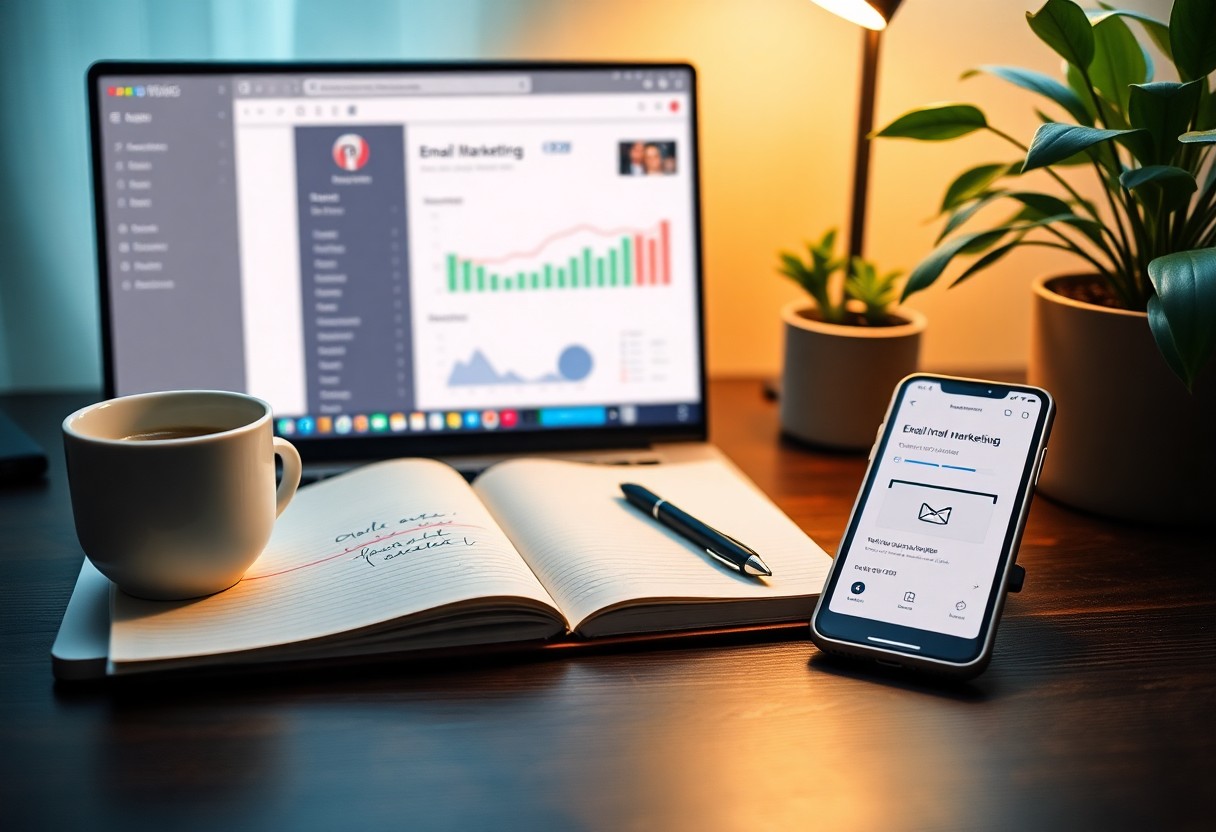Categories
Getting Started with Email Marketing: A Complete Beginner's Guide

Getting Started with Email Marketing: A Complete Beginner's Guide
Most businesses recognize email marketing as one of the most effective digital marketing channels available today. You're about to discover how to harness this powerful tool to grow your business and connect with your audience. Whether you're launching your first campaign or looking to refine your email marketing strategy, this comprehensive guide will walk you through everything you need to know. From building your email list to crafting compelling messages that convert, you'll learn the fundamental principles and best practices that drive successful email marketing campaigns.
Key Takeaways:
- Email Automation and analytics tools are crucial components for maximizing campaign efficiency and tracking performance metrics
- A user-friendly interface design enables both novice and experienced marketers to create and manage email campaigns effectively
- Building subscriber engagement through personalized content and proper list management leads to better deliverability rates and business growth

Understanding Email Marketing Fundamentals
What is Email Marketing
The practice of email marketing involves sending commercial messages to a group of contacts who have given their permission to receive such communications. You can use it to promote products, share news, build relationships, and drive engagement with your brand. Through strategic email campaigns, you can reach your audience directly in their inbox with personalized, relevant content.
Why Email Marketing Matters
While social media and other digital channels continue to emerge, email marketing remains one of the most effective marketing tools, delivering an average ROI of $36 for every $1 spent. You can reach your customers directly, measure results accurately, and scale your marketing efforts efficiently.
It's worth noting that email marketing gives you complete control over your communication channel. You own your email list, unlike social media platforms where algorithms can limit your reach. With 4 billion daily email users worldwide, you have an opportunity to connect with your audience where they're already active.
Key Terms and Concepts
One necessary aspect of successful email marketing is understanding the basic terminology. You'll need to familiarize yourself with terms like open rate, click-through rate (CTR), bounce rate, and subscriber segmentation to effectively manage your campaigns.
A deeper understanding of these metrics helps you measure and improve your email marketing performance. You'll want to track your delivery rate, which typically should be above 95%, and your open rates, which vary by industry but average around 20%. Understanding these benchmarks helps you set realistic goals for your campaigns.
Legal Requirements and Compliance
Legal compliance in email marketing centers around data protection and anti-spam laws like GDPR and CAN-SPAM Act. You must obtain explicit consent from subscribers, provide clear unsubscribe options, and protect your subscribers' personal information.
Requirements vary by region and industry, but some universal principles apply. You need to maintain accurate records of consent, honor unsubscribe requests promptly, and include your physical business address in commercial emails. Following these guidelines not only keeps you compliant but also builds trust with your audience.
Types of Email Marketing Campaigns
Some common types of email marketing campaigns help you connect with your audience at different stages of their journey.
- Welcome series
- Newsletters
- Promotional campaigns
- Transactional emails
- Re-engagement campaigns
| Campaign Type | Primary Purpose |
|---|---|
| Welcome Emails | Introduce your brand and set expectations |
| Newsletters | Share valuable content and updates |
| Promotional Emails | Drive sales and conversions |
| Transactional Emails | Confirm actions and provide information |
| Re-engagement | Reactivate inactive subscribers |
This guide will help you understand each type in detail.
Welcome Emails
Marketing research shows that welcome emails have an average open rate of 82%, making them your most effective email type. These automated messages set the tone for your future communications and help establish a strong relationship with new subscribers.
Newsletter Campaigns
One of the most versatile email marketing tools, newsletters keep your audience informed and engaged with your brand through regular updates, industry insights, and valuable content.
Campaigns that include newsletters typically see 40% higher engagement rates when they maintain consistent delivery schedules and provide relevant, valuable content to their subscribers.
Promotional Emails
Little drives sales quite like well-crafted promotional emails. These campaigns showcase your products, services, and special offers to encourage purchases and conversions.
Emails with personalized promotional content generate 6x higher transaction rates than generic ones, making them vital for your revenue growth strategy.
Transactional Emails
Welcome to the world of automated responses - transactional emails are triggered by specific actions your customers take, such as purchases, password resets, or shipping confirmations.
Another key aspect of transactional emails is their impressive 8x higher open rates compared to traditional marketing emails, making them perfect opportunities for cross-selling and building trust.
Re-engagement Campaigns
Welcome back strategies focus on rekindling relationships with inactive subscribers through personalized content, special offers, and feedback requests.
Transactional data shows that successful re-engagement campaigns can recover up to 45% of inactive subscribers, making them valuable for maintaining a healthy email list.
Essential Steps to Start Email Marketing
Setting Marketing Goals
Steps to effective email marketing begin with setting clear, measurable goals. Your objectives might include increasing sales, boosting website traffic, or improving customer engagement. Research shows that marketers who set goals are 376% more likely to report success. Define specific metrics like open rates, click-through rates, and conversion rates to track your progress.
Building Your Email List
If you want to succeed in email marketing, start by building a quality email list of engaged subscribers who have explicitly opted in to receive your communications. Focus on attracting subscribers who are genuinely interested in your offerings.
Plus, you can accelerate your list growth by implementing multiple sign-up forms on your website, offering valuable lead magnets, and utilizing social media channels to promote your email content. Studies indicate that personalized opt-in forms can increase conversion rates by up to 42%.
Choosing an Email Marketing Platform
If you're new to email marketing, selecting the right platform is imperative for your success. Look for features like user-friendly interface, automation capabilities, responsive templates, and comprehensive analytics.
Platform selection should align with your business needs, budget, and growth plans. Consider factors like list size limits, monthly send volumes, and integration capabilities. Modern email marketing platforms offer features like A/B testing, which can improve open rates by 49%, and segmentation tools that can increase revenue by up to 760%.
Creating Your First Campaign
Email campaigns need careful planning and execution. Start with a compelling subject line, create valuable content, and include clear calls-to-action. Your design should be mobile-responsive, as 81% of emails are now opened on mobile devices.
Creating effective campaigns involves understanding your audience's preferences and behaviors. Use segmentation to deliver targeted content, implement personalization to increase engagement, and maintain consistent branding throughout your messages. Research shows that personalized email campaigns receive 29% higher open rates and 41% higher click-through rates.
Testing and Quality Assurance
An imperative part of email marketing success is thorough testing. Check your emails across different devices and email clients, verify all links work correctly, and proofread your content carefully. Data shows that 75% of subscribers judge email credibility by overall design quality.
Goals of testing include ensuring optimal deliverability, maintaining professional appearance, and maximizing engagement rates. Implement A/B testing for subject lines, content, and send times. Regular testing can help you achieve up to 28% better open rates and significantly improve your campaign performance.

Email Marketing Best Practices
After understanding the fundamentals of email marketing through this comprehensive getting started guide, implementing proven best practices will help you achieve better results with your campaigns.
Writing Effective Subject Lines
Subject lines serve as your email's first impression. You should keep them clear, concise, and compelling – ideally under 50 characters. Including personalization, creating urgency, or asking questions can increase open rates by up to 50%. Avoid spam trigger words and excessive punctuation to maintain deliverability.
Crafting Compelling Content
Some vital elements of engaging email content include clear value propositions, scannable formatting, and relevant messaging that resonates with your audience's needs and interests.
A well-structured email should maintain a focused message, incorporate engaging visuals, and include clear calls-to-action. You can improve engagement rates by segmenting your audience and delivering personalized content that addresses their specific pain points and preferences.
Email Design Guidelines
Writing emails that convert requires a clean, professional design with a clear hierarchy. You should use branded colors, maintain adequate white space, and ensure your CTAs stand out visually.
To maximize impact, your email design should follow a responsive layout that adapts to different screen sizes. You can enhance readability by using web-safe fonts, maintaining consistent styling, and keeping your design elements aligned with your brand guidelines.
Mobile Optimization
Practices for mobile optimization include using single-column layouts, larger font sizes (minimum 14px), and touch-friendly buttons. With over 60% of emails now opened on mobile devices, these elements are vital for success.
Compelling mobile experiences require testing across different devices and email clients. You can improve your mobile conversion rates by implementing responsive images, optimizing load times, and ensuring your CTAs are easily tappable on smaller screens.
Timing and Frequency
Effective email scheduling depends on your audience's behavior patterns. You should analyze your metrics to identify optimal sending times and maintain a consistent cadence that keeps your subscribers engaged without overwhelming them.
Another key aspect of timing is understanding your specific industry patterns. You can improve your campaign performance by testing different sending times, monitoring engagement metrics, and adjusting your schedule based on data-driven insights about when your audience is most responsive.
Email Marketing Success Factors
For effective email marketing, you need to focus on several key elements that drive campaign performance. Master the fundamentals of email marketing by implementing these important success factors:
- Strategic list segmentation
- Personalized content delivery
- Optimal deliverability practices
- Regular A/B testing
List Segmentation
One of the most powerful ways to improve your email marketing results is through proper list segmentation. By dividing your audience based on demographics, behavior, or preferences, you can deliver more relevant content. Studies show that segmented campaigns can lead to a 760% increase in revenue.
Personalization Techniques
Success in email marketing heavily relies on personalization. You can increase open rates by 26% simply by using personalized subject lines and tailoring content to specific subscriber groups.
Another important aspect of personalization is utilizing dynamic content blocks and behavioral triggers. You can customize email content based on past purchases, browsing history, and engagement patterns to create more meaningful connections with your subscribers.
Deliverability Optimization
The foundation of successful email marketing lies in ensuring your messages reach the inbox. You need to maintain a clean list, authenticate your emails, and follow best sending practices to achieve optimal deliverability rates.
Techniques for improving deliverability include implementing SPF and DKIM records, monitoring bounce rates, and regularly cleaning your email list. Industry data shows that proper authentication can improve delivery rates by up to 10%.
A/B Testing Strategies
Personalization and continuous improvement go hand in hand with effective A/B testing. You should regularly test different elements of your emails to understand what resonates best with your audience.
For instance, you can test various subject lines, call-to-action buttons, send times, and content formats to optimize your campaign performance. Assume that every element of your email can be improved through systematic testing and data analysis.
Measuring and Analytics
Once again, measuring the success of your email campaigns is necessary for improving your marketing strategy. As outlined in Email Marketing 101: Your Complete Guide to Campaign Success, understanding your metrics helps you make informed decisions about your future campaigns.
Key Performance Indicators (KPIs)
Analytics form the foundation of your email marketing success. Your primary KPIs should include open rates (typically ranging from 15-25%), click-through rates (averaging 2.5%), conversion rates, bounce rates (keep below 2%), and unsubscribe rates. These metrics help you understand how your audience engages with your content and where you need to improve.
Tracking Tools and Methods
For effective email campaign monitoring, you'll need reliable tracking tools that provide real-time data about your campaigns' performance. Most email marketing platforms offer built-in analytics dashboards that track necessary metrics automatically.
To maximize your tracking effectiveness, you should implement UTM parameters in your email links, set up conversion tracking in your analytics platform, and use A/B testing to compare different campaign elements. These methods provide comprehensive insights into your audience's behavior and campaign performance.
Interpreting Campaign Results
Little details in your campaign data can reveal significant insights about your audience's preferences and behaviors. Understanding these patterns helps you optimize future campaigns for better engagement and conversion rates.
Tools and metrics tell different parts of your story. When analyzing results, you should compare your metrics against industry benchmarks, segment your data by audience groups, and look for patterns in engagement times and devices used. This comprehensive approach helps you build a complete picture of your campaign's effectiveness.
Making Data-Driven Decisions
On the path to email marketing success, your data serves as your guide. Using your analytics insights helps you refine your content, timing, and targeting strategies to improve campaign performance continuously.
Indicators like engagement trends, conversion patterns, and subscriber behavior should inform your future campaign strategies. You can use this information to segment your audience more effectively, personalize content, and optimize send times. Regular analysis of these metrics enables you to make informed decisions that drive better results.

Troubleshooting and Optimization
Common Email Marketing Challenges
Assuming you're new to email marketing, you'll likely encounter several challenges. Many marketers face issues like low open rates (industry average is 21.5%), declining engagement, spam folder placement, and bounced emails. Your subscriber list might shrink due to unsubscribes, or you may struggle with creating content that resonates with your audience.
Solutions and Workarounds
Assuming you want to overcome these challenges, you can implement several proven solutions. Your first step should be to segment your email list based on subscriber behavior and preferences. You can improve deliverability by authenticating your domain with SPF and DKIM records, and maintain consistent sending schedules.
Workarounds for common issues include using A/B testing to optimize subject lines, sending at different times to find the best engagement window, and personalizing content based on subscriber data. You can also implement double opt-in to ensure list quality and reduce bounce rates.
Performance Improvement Tips
Solutions for better email performance include:
- Clean your email list regularly
- Optimize email design for mobile devices
- Use compelling subject lines
- Segment your audience effectively
Though testing different approaches is your best path to success.
Email marketing success relies on continuous optimization:
- Monitor engagement metrics regularly
- Test different content formats
- Analyze click-through patterns
- Adjust sending frequency based on data
Though maintaining consistent quality is your primary goal.
Maintaining List Health
Assuming you want to keep your email list healthy, regular maintenance is important. You should remove inactive subscribers after re-engagement attempts, verify email addresses periodically, and ensure proper list segmentation. Your list hygiene directly impacts deliverability rates and engagement metrics.
Common list maintenance practices include removing hard bounces immediately, monitoring engagement patterns, and implementing sunset policies for inactive subscribers. You can improve your sender reputation by maintaining a clean list, which typically leads to better inbox placement and higher engagement rates.
Conclusion
Presently, you have all the necessary tools and knowledge to begin your email marketing journey. By following this guide, you can create engaging campaigns, build your subscriber list, and measure your success through analytics. Your path to email marketing success starts with selecting the right platform, crafting compelling content, and understanding your audience's needs. As you implement these strategies, you'll discover that email marketing is a powerful channel for connecting with your customers and growing your business. Take the first step today, and watch your email marketing efforts transform into measurable results.
FAQ
Q: How do I build my first email marketing list as a beginner?
A: Start by adding a sign-up form to your website, offering valuable content like free guides or newsletters in exchange for email addresses. Ensure your forms are GDPR-compliant and clearly state how you'll use subscribers' information. Focus on quality over quantity and never purchase email lists.
Q: What should I include in my first email marketing campaign?
A: Your first campaign should include a welcoming subject line, clear branding, valuable content relevant to your audience, a strong call-to-action, mobile-responsive design, and proper introduction of your business. Keep the message concise and include both text and visual elements for better engagement.
Q: How often should I send marketing emails to my subscribers?
A: Start with one email per week and monitor engagement metrics. Adjust frequency based on open rates, click-through rates, and unsubscribe rates. Different audiences have different preferences - some may engage better with bi-weekly emails, while others might prefer monthly communications.
Q: What metrics should I track to measure email marketing success?
A: Focus on key performance indicators including open rates (industry average 15-25%), click-through rates (2-5%), conversion rates, bounce rates, and unsubscribe rates. Also track list growth rate and overall return on investment (ROI) to evaluate campaign effectiveness.
Q: How can I improve my email deliverability rates?
A: Maintain a clean email list by regularly removing inactive subscribers and bounced addresses. Use double opt-in verification, personalize content, avoid spam trigger words, and authenticate your domain with SPF and DKIM records. Test emails before sending and ensure your content provides value to recipients.
TextBuilder.ai Assistant
Ask me anything about our platform